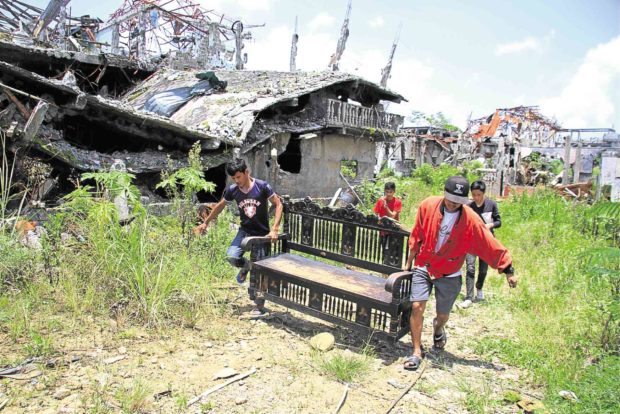
Residents carry a wooden chair retrieved from what used to be their home in Marawi City. —RICHEL V. UMEL
MARAWI CITY — Residents of this city displaced by the war on Islamic State (IS) set foot for the first time in five months on their homes—or what was left of these—in a visit allowed by soldiers who continued to dig up the remains of those who died and disarm bombs left unexploded during the war.
Up to 7,000 people residing in an area known as ground zero of the fighting were allowed near structures that barely stood but which the people had known as home.
As the people returned for the visit, soldiers continued to carefully dig into rubble for skeletal remains and unexploded bombs in 24 villages where fighting was heaviest during the war on IS that started on May 23 last year.
Remains of war
The people arrived in all types of vehicles, waving as they crossed the Baloi Bridge into the village of Tolali at the heart of the city, which IS followers Maute and Abu Sayyaf groups tried to turn into an IS province.
Some of the people were overheard muttering Arabic words while they surveyed the ruins.
Many buildings were now just mounds of steel and concrete. Others were still standing though bullet-riddled and defaced.
Retrieving valuables
The white tower and minaret of the village mosque were pockmarked with bullet holes.
A man stood motionless for several minutes outside of what used to be his house before slowly opening its door.
Many of the people came out of the buildings carrying stuff from spring beds to tattered curtains.
Others carried TV sets or refrigerators from inside buildings spared by the ravages of war.
Col. Romeo Brawner Jr., deputy commander of the Joint Task Force Ranao which oversaw the war and now oversees cleanup operations, said the military allowed only one family per vehicle.
The congestion was still heavy, forcing policemen and soldiers to direct traffic. Medics were on hand, in case any of the returning residents were injured by sharp objects in the ruins.
Brawner said soldiers and policemen guarded against anyone straying outside what he described as Sector 1, or the first area in ground zero cleared for visits by residents.
Bomb found
Just minutes before the residents arrived in Tolali, soldiers found and detonated a bomb, Brawner said.
The military expected more remains to be found during the three-day visit of residents, called Kambisita.
Since the war ended last October, Brawner said eight sets of remains had been found in ground zero.
Task Force Bangon Marawi, the provincial government of Lanao del Sur and city government of Marawi organized Kambisita to let residents see for themselves their homes and salvage belongings.
Fear persists, however, of residents not being allowed to reclaim their homes or property.
Destruction greeted residents visiting their homes in Marawi City for the first time in five months. —PHOTO FROM LANAO DEL SUR PIO
A group of residents and supporters, Ranaw Multi-Sectoral Movement (RMSM), said the government should just allow residents to rebuild the city on their own.
Let people decide
In a statement on Friday, RMSM said the people should be allowed to get back on their feet with as little interference from the government as possible.
The group said the Maranao people had survived previous wars and able to rise again without outside help.
RMSM said the people should be allowed to rebuild Marawi “one house at a time, one mosque at a time, one village at a time.”
“Through the years, Marawi stood fast, thrived and flourished,” the group said.
For the government to build a military base or an economic zone in Marawi would be “an invasion of a different kind,” said RMSM.
“This one threatens to rob our soul,” it said. —Reports from Richel Umel, Divina Suson, Allan Nawal and Jigger Jerusalem